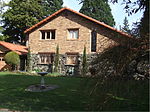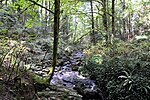Angkor I
Angkor I is an outdoor stainless steel sculpture by Lee Kelly, located at Millennium Plaza Park in Lake Oswego, Oregon, in the United States. The 1994 sculpture stands 14 feet (4.3 m) tall and weighs 1,000 pounds (450 kg), and was influenced by his visit to Southeast Asia one year prior. In 2010, Angkor I appeared in an exhibition of Kelly's work at the Portland Art Museum. In 2011, it was installed at Millennium Plaza Park on loan from the Portland-based Elizabeth Leach Gallery. The Arts Council of Lake Oswego began soliciting donations in 2013 in an attempt to keep the sculpture as part of the city's permanent public art collection, Gallery Without Walls. The fundraising campaign was successful; donations from more than 40 patrons, including major contributions from the Ford Family Foundation and the Oregon Arts Commission, made purchase of the sculpture possible. Angkor I has been called a "recognizable icon" and a "gateway" to the park's lake.
Excerpt from the Wikipedia article Angkor I (License: CC BY-SA 3.0, Authors).Angkor I
Geographical coordinates (GPS) Address Nearby Places Show on map
Geographical coordinates (GPS)
| Latitude | Longitude |
|---|---|
| N 45.417754 ° | E -122.66467 ° |
Address
Oregon, United States
Open on Google Maps










